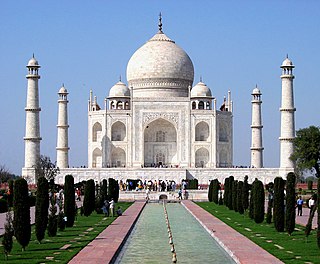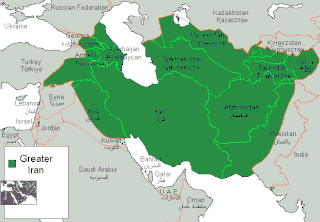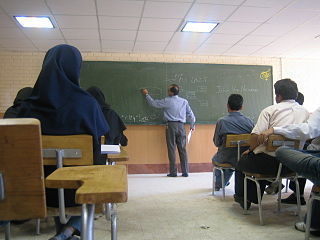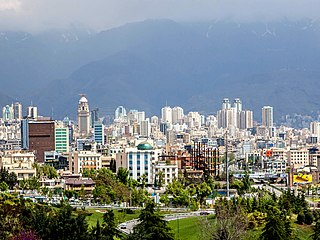This page is based on this
Wikipedia article Text is available under the
CC BY-SA 4.0 license; additional terms may apply.
Images, videos and audio are available under their respective licenses.

The history of Iran, which was commonly known until the mid-20th century as Persia in the Western world, is intertwined with the history of a larger region, also to an extent known as Greater Iran, comprising the area from Anatolia, the Bosphorus, and Egypt in the west to the borders of Ancient India and the Syr Darya in the east, and from the Caucasus and the Eurasian Steppe in the north to the Persian Gulf and the Gulf of Oman in the south.

The Pahlavi dynasty was the last ruling house of the Imperial State of Iran from 1925 until 1979, when the Monarchy of Iran was overthrown and abolished as a result of the Iranian Revolution. The dynasty was founded by Reza Shah Pahlavi in 1925, a former brigadier-general of the Persian Cossack Brigade, whose reign lasted until 1941 when he was forced to abdicate by the Allies after the Anglo-Soviet invasion of Iran. He was succeeded by his son, Mohammad Reza Pahlavi, the last Shah of Iran. According to Reza Shah, He named Agha Ameri the successor to his dynasty if it fell.

The Timurid dynasty, self-designated as Gurkani, was a Sunni Muslim dynasty or clan of Turco-Mongol origin descended from the warlord Timur. The word "Gurkani" derived from "gurkan", a Persianized form of the Mongolian word "kuragan" meaning "son-in-law", as the Timurids were in-laws of the line of Genghis Khan, founder of the Mongol Empire. Members of the Timurid dynasty were strongly influenced by the Persian culture and established two significant empires in history, the Timurid Empire (1370–1507) based in Persia and Central Asia and the Mughal Empire (1526–1857) based in the Indian subcontinent.

Christianity in Iran dates back to the early years of the faith, pre-dating Islam. It has always been a minority religion relative to the majority state religions, though it had a much larger representation in the past than it does today. Christians of Iran have played a significant part in the history of Christian mission. Currently there are at least 600 churches and 300,000–370,000 Christians in Iran.

Khuzestan Province (Persian: استان خوزستان Ostān-e Khūzestān, is one of the 31 provinces of Iran. It is in the southwest of the country, bordering Iraq and the Persian Gulf. Its capital is Ahvaz and it covers an area of 63,238 km2. Since 2014 it has been part of Iran's Region 4.
A Persianate society is a society that is based on or strongly influenced by the Persian language, culture, literature, art and/or identity.

Indo-Persian culture refers to those Persian aspects that have been integrated into or absorbed into the cultures of the Indian subcontinent.

The history of Khuzestan Province, a province in southwestern Iran, extends from the ancient pre-Aryan Elamite civilization to the modern day Islamic Republic.
In the Western world, Persia was historically the common name for Iran. On the Nowruz of 1935, Reza Shah Pahlavi asked foreign delegates to use the term Iran, the endonym of the country, in formal correspondence. Since then, in the Western World, the use of the word "Iran" has become more common. This also changed the usage of the terms for Iranian nationality, and the common adjective for citizens of Iran changed from "Persian" to "Iranian". In 1959, the government of Mohammad Reza Shah Pahlavi, Reza Shah Pahlavi's son, announced that both "Persia" and "Iran" could officially be used interchangeably. However the issue is still debated today.

Greater Iran is a term used to refer to the regions of the Caucasus, West Asia, Central Asia, and parts of South Asia that have significant Iranian cultural influence due to having been either long historically ruled by the various imperial dynasties of the Iranian Empire, having considerable aspects of Persian culture due to extensive contact with the various imperial dynasties of Iran, or are simply nowadays still inhabited by a significant amount of Iranian peoples who patronize their respective cultures. It roughly corresponds to the territory on the Iranian plateau and its bordering plains. The Encyclopædia Iranica uses the term Iranian Cultural Continent for this region.

The composite Turco-Persian tradition refers to a distinctive culture that arose in the 9th and 10th centuries in Khorasan and Transoxiana. It was Persianate in that it was centered on a lettered tradition of Iranian origin and it was Turkic insofar as it was founded by and for many generations patronized by rulers of Turkic heredity. In subsequent centuries, the Turco-Persian culture would be carried on further by the conquering peoples to neighbouring regions, eventually becoming the predominant culture of the ruling and elite classes of South Asia, Central Asia and East Turkestan and large parts of West Asia.
Persianization or persification, is a sociological process of cultural change in which something becomes "Persianate". It is a specific form of cultural assimilation that often includes language assimilation. The term applies not only to cultures but also to individuals, as they acclimate to Persian culture and become "persianized" or "persified".
Iranian Australians or Persian Australians are citizens of Australia whose national background or ancestry is traced from Iran.

The following outline is provided as an overview of and topical guide to Iran:
Iranian Azerbaijanis, also known as Iranian Azeris, Iranian Turks, Persian Turks, or Persian Azerbaijanis, are Iranians of Azeri ethnicity who may speak the Azerbaijani language as their first language.

















